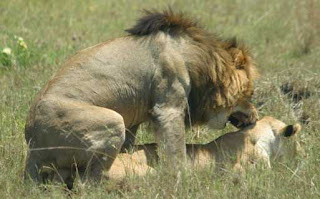The Cycle of Love

I am about to discuss why non-human animals did not invent their own religions and why premarital sex is not an issue for animals… Really, that was joke.
The study of animal courtship, sexual behavior, and sexuality (and primate sexuality especially) is a rapidly developing field. Complicated touches, vocalization and touching, intricate displays of beauty and fighting prowess, fear, aggression, all contribute to sexual behavior and courting in animals. Courtship is the collection of ritualized behaviors unique to each species that leads up to and enables animals to successfully mate [1]. Mating is the placement of sperm, the male sex cells, in the vicinity of eggs, the female sex cells. Animals utilize a mixture of methods to mate, all of which promote fertilization, or fusion of sperm and egg. Fertilization initiates development of a new organism, the beginning of the next generation. Fusion of sperm and egg, known as sexual reproduction, is the main means of reproduction on earth. It results in an assortment of genetically diverse offspring that are better able to survive a changing environment, thus increasing the potential for preservation of the species [1]
Animal sexual behavior takes many different forms, even within the same species [3]. Researchers have observed monogamy, promiscuity, sex between species, sexual arousal from objects or places, sex apparently via duress or coercion, copulation with dead animals, homosexual, heterosexual and bisexual sexual behaviour, and situational sexual behaviour and a range of other practices among animals other than humans [3].
Animals’ sexuality used to be believed that only humans and numerous species performed sexual acts other than for reproduction, and that it was instinctive and a simple response to the "right" stimulation. The present understanding is that many species believed monogamous have now been proven to be promiscuous or opportunistic in nature, a wide range of species appear both to masturbate and to use objects as tools to help them do so, in many species animals try to give and get sexual stimulation with others where procreation is not the aim [3].
Courting and Mating Examples on exact species
Frogs carry out a well-timed courtship dance, in which the male climbs on the back of the female and clasps her in his arms. This stimulates the female to lay eggs, which the male sprays with his sperm [2].
Most birds transfer sperm by aligning their cloacas, an opening in the lower abdomen designed for reproduction as well as excretion of wastes. Some birds, such as bald eagles and swifts, accomplish the alignment of cloacas in mid-flight [2].
Gray wolf courtship looks very much like the play of young wolves, involving a sequence of head-rubbing, snuffling, nipping, and snout grabbing, all motions with a gentle quality quite distinct from the fierceness of a real fight [2].
Bottlenose Dolphin males have been observed working in pairs to follow and/or restrict the movement of a female for weeks at a time, waiting for her to become sexually receptive. The same pairs have also been observed engaging in intense sexual play with each other [3].
Whip-tailed lizard females have the ability to reproduce through parthenogenesis and as such males are rare and sexual breeding non-standard. Females engage in sexual behavior to stimulate ovulation, with their behavior following their hormonal cycles; during low levels of estrogen, these (female) lizards engage in "masculine" sexual roles. Those animals with currently high estrogen levels assume "feminine" sexual roles [3].
Above >>>> Almost looks like it's heart-shaped.
As for humans, courtship and mating behavior is somewhat difficult to explain. I won’t even try to discuss it because I am not credible in reporting about this. Also there's another topic related to all of this that I do not want to talk about. It's called zoophilia (attributed to bestiality).
References:
[1]. http://encarta.msn.com/encyclopedia_761595481/Animal_Courtship_and_Mating.html
[2]
http://encarta.msn.com/encyclopedia_761595481_2/Animal_Courtship_and_Mating.html
[3]
http://en.wikipedia.org/wiki/Non-human_animal_sexual_behavior


Comments